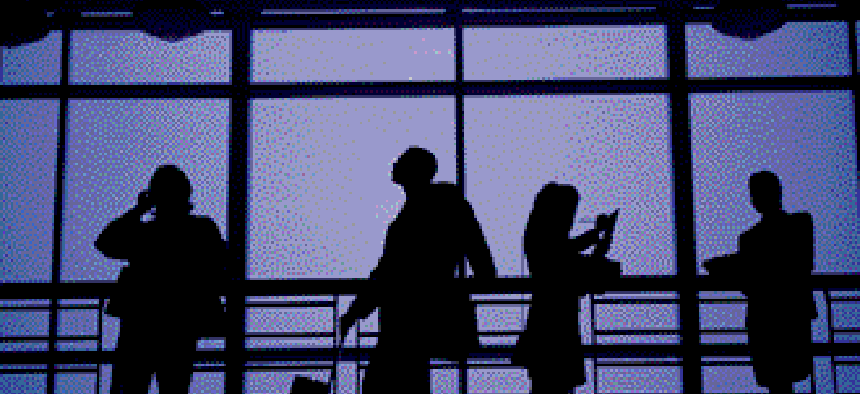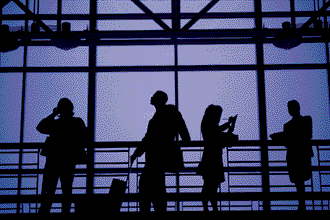Let's go to the tape

What may appear to be harmless loitering near the entrance of a subway tunnel could escalate quickly into a terrorist attack. Video surveillance helps monitor such vulnerable public areas, but the growing numbers of cameras have put a strain on the people tasked with monitoring them.
What may appear to be harmless loitering near the entrance of a subway tunnel could escalate quickly into a terrorist attack. Video surveillance helps monitor such vulnerable public areas, but the growing numbers of cameras have put a strain on the people tasked with monitoring them."I've been in some command centers where there are 40 to 50 screens, and some of those are multiplex, where there are four different views on one screen," said Brian Eckert, vice president sales and marketing for ObjectVideo Inc. of Reston, Va."There are studies that have been done where somebody is sitting in front of video screens, and a tank drives through one of the scenes, and they don't notice it."Because of the growth in the number of cameras, and because human attention spans degenerate over time, public safety and security forces have an increasing interest in software that can monitor video.ObjectVideo's VEW software detects, identifies, classifies and tracks objects in real time. It generates alerts when security rules are violated, and integrates with video camera systems, Eckert said.The investigation of the London subway bombing showed the effectiveness of video, particularly as a forensic tool, Eckert said."Guards are trying to observe anomalies, or behaviors or patterns, that may give them advance notice" of a possible incidence of violence, he said "You can only imagine the difficulty associated with a guard being able to take all of that in and spot that anomaly as it's occurring. Our technology automates that, it reviews the video and it identifies when the security policy has been breached."VEW software converts security policies into natural language rules. For instance, a security official can tell the system, "Notify me if someone leaves a bag behind." or "Tell me if someone crosses a perimeter." The software also can monitor suspicious activity, such as loitering near a restricted area.When a breach occurs, an alert goes to a command station or to security officers' personal digital assistants or mobile computers."The mobile alerts take the guard forces away from screens and put them out in the field, where they can be a deterrent," Eckert said. "If they are roaming the area, they can quickly respond to an incident."In Spain, Barcelona Metro, which annually carries more than 320 million passengers, recently began installing ObjectVideo to monitor its facilities. The project will concentrate on intruder detection, primarily in employee-only areas such as tunnels, overnight train parking lots and restricted station areas.Detection in Metro stations can be difficult because of changing light levels and the continual entrance and exit of trains. ObjectVideo's object classification filters reoccurring elements such as trains.The system eventually could be used to monitor station platforms for abandoned luggage or abnormal behavior by passengers.L-3 Communications Inc.'s Praetorian Security Systems also has built-in intelligence that can alert authorities if something is amiss. The New York company's system also has another way to help guards follow the action on multiple screens."We take all those monitors and bring them into what we call a single common operations picture, and we do it in three dimensions," said Jeffrey Heubusch, a spokesman for L-3 Praetorian systems. "The person sitting at that command-and-control desk is able to virtually fly through an area of interest, whether it's a hot spot in the military field, an energy plant or a transportation hub."Although it is much more complex, the experience is like a video game, in that the controller can swoop down alley ways, around corners and in and out of buildings, Heubusch said.Developed for the military, the technology has a future at airports, seaports, borders and energy facilities, according to L-3.The Army is using the technology at facilities in the Middle East, and it is installed at the Jacksonville International Airport in Florida, Heubusch said.A recent incident in Jacksonville demonstrates one of Praetorian's capabilities. While waiting for a flight, a passenger put her cell phone on the seat next to her. When next she reached for it, it was gone.Using the time stamps associated with the images from Praetorian, security officials were able to pull up video of a person stealing the phone."They saw exactly who walked up and picked up her phone," Heubusch said. "And they were able to visually track ? that person walking down hallways, crossing walk ways and going to his own gate and boarding a plane."Access to the tracking was fast enough that authorities were able to board the plane and apprehend the suspect.The success of intelligent video monitoring has fostered further evolution of the technology.ObjectVideo, for example, is working on a system designed for border protection. Rather than use stationary cameras, which have a necessarily limited range of view, the system uses cameras that can scan the terrain. The system will allow fewer cameras to cover more terrain than is possible today.Another ObjectVideo installation integrates radio frequency identification technology. Installed in an airport, the system monitors a restricted zone. Comparing video and RFID data, it determines if the correct number of people, according to security policies, is in that restricted zone.The system also is becoming more portable. Rather than connecting to applications running on a central server, ObjectVideo has programmed its capability into a chip and is providing it to manufacturers that supply security equipment such as digital video recorders."They put that chip into their device, and now that digital video recorders or camera is intelligent," Eckert said. "Let's say you want to put a camera up at the far side of an airport, but the cost of putting fiber in is prohibitive. Where the intelligence is at the edge of the system, a WiFi smart camera can be hung. The real trend is putting the intelligence into the devices."Staff Writer Doug Beizer can be reached at dbeizer@postnewsweektech.com.

Video eyes have it
What not to watch

Companies such as L-3 Communications Inc. are developing technology that lets security personnel at airports and other transportation hubs more efficiently process data that is coming in from more than once source at a time.
Digital stock image
Video eyes have it
What not to watch

